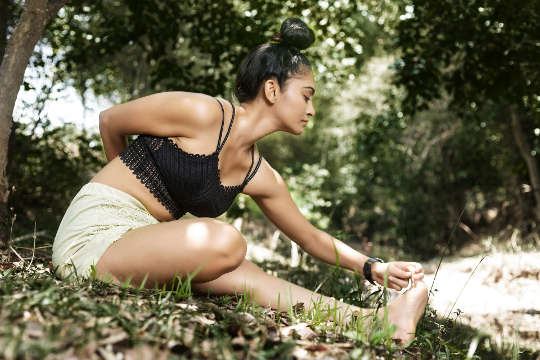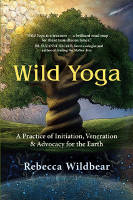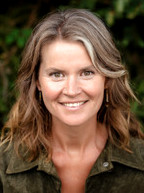
Image by Anil sharma
To be truly alive is to live from within our body, fully aware. Children, like animals, naturally inhabit their bodies with wonder, joy, and innocence. As a child, I loved to swim in the ocean near my grandparents’ home on the Jersey shore. With sand in my toes, salt on my tongue, and the sound of waves intermingled with the cries of seagulls, I knew that I was alive and a part of a grand and exquisite world.
Our dominant culture trains us to be disembodied. Separating our minds from our bodies makes humans less healthy but more docile and obedient to external power structures.
When we begin school, we are taught to sit at a desk most of the day. We learn to fall out of our bodies and into our heads, to let our minds rule. We are taught that our thoughts make us intelligent.
To survive in school, we learn to ignore our bodies’ wishes and impulses, be disciplined, and sit quietly. We go on living our lives from our heads. Losing touch with our bodies disconnects us from ourselves. Tragically, that is what is considered healthy and sensible in our society.
Get The Latest By Email
Calling Us Back Home into the Body
Yoga asanas, the body postures of yoga, have the power to call us back home. To bring us back into the body and show us that being there is essential.
I participated in my first asana class in my senior year of college. Through cancer, my body had been showing me that it was no longer willing to live as the servant of my mind. Still recovering from a thoracic-section biopsy surgery, I found the asana class painful and did not try yoga again for many years.
I played soccer and basketball in elementary and high school. I felt strong and graceful maneuvering a ball with feet or hands to the goal or basket. After college, I ran a marathon, joined a US Masters Swimming team, and swam 4.4 miles across the Chesapeake Bay.
Yoga asana was not like sports. It asked more of me. I tried asana again in my late twenties and committed to participating in a weekly class. I longed to be more flexible but usually encountered my stiffness. I felt humbled. My asana practice asked me to show up on my mat and be present with my body exactly as it was.
I became aware of the places that felt painful or tense and noticed where I felt disconnected. I aimed to be gentle with myself and accept my inadequacies and discomfort.
Coming Back into the Body
Coming back into my body was difficult. I thought the monthlong yoga teacher training in Costa Rica would help me become more flexible, but after a week, my hamstrings were screaming. Trying to force them loose had made them tighter. I stumbled back and forth from my dorm room to class on the jungle trails. Something needed to bend, and it would not be my hamstrings.
When I slowed down and reminded myself that yoga is not about accomplishing poses, I relaxed and let go of my expectations. My muscles stretched more easily as my movements began to come from within. In some moments, I felt beautiful as I flowed from pose to pose — like how I imagined the trees, ocean, and moon feel when they are shining brightly.
Accepting and Listening to the Body
My asana practice was a choice to return to my body. To accept and listen to it. Yoga is the willingness to show up and attend. Some days, I simply lie on my mat in my yoga practice. I am tired and want stillness. Other days, I need to turn on music, stretch, and feel strong.
Listening to your body is vital. Each of us is unique and called to move differently. Yoga helps us cultivate a deep and loving relationship with ourselves. Simple movements and poses can foster flexibility and strength as much as challenging ones.
The Body as an Intimate Companion
Yoga taught me how to live at a loving pace with my body. In Costa Rica, the moist heat of the tropics forced me to slow down and embrace my body as an intimate companion. Sometimes I can still get disconnected and become overly immersed in work or other things I need to do.
When I lie on my yoga mat and tune in, often the first responses to arrive are silent tears. These tears seem to express gratitude, as if my body is saying, “Thank you for taking the time to be with me.”
Connecting with Your Body
Go outside and find a place to lie on the ground. Or, if you are inside, imagine yourself in a wild place. For example, if you are near a beach, do beach yoga.
Lie on your back in the sand or insulate yourself with a mat, towel, or sarong. Move in any way your body wants, or be still. Perhaps rock your head side to side as you let your opposite hip rise off the ground and then thump down. Roll onto your belly into Sphinx Pose (Salamba Bhujangasana). Raise your upper body and relax your pelvis and legs with wrists and palms flat on the Earth. Or lift your arms and legs to fly in Superman Pose (Viparita Shalabhasana). Imagine yourself flying over the ocean.
What sensations, emotions, or images arise? What wants to happen next? Notice how this place influences you.
Wild Yoga Practices for Listening to the Intelligence of Your Body
As you engage in these practices, be patient with yourself. To listen in the ways that I am inviting takes time. Don’t give up. Be present with whatever is happening. Seek to create a loving relationship with your body and nature.
-
Choose a moment in your day, perhaps first thing in the morning. Lie down. Notice what you feel. Turn on your favorite song or soak in the silence. See whether your body prefers to move or be still. Remain still until a movement arises. Notice how your body wants to move — perhaps by remembering poses from a yoga class or by making up movements.
-
After witnessing your body in the practice above, ask your body how it wants to move and listen for a response. If nothing comes, be patient and keep asking. If the slightest urge to move arises, follow it. Notice what happens next. Are you called to stop or move differently? Follow the urges of your body.
-
Then, lie still and notice without judgment how your body feels. Close your eyes. Breathe deeply. Imagine a wild place is holding you. Scan your body from toes to head, focusing your attention on each part of your body in turn. Notice if you feel any sensations. Stay out of your mind. Imagine your body is speaking. What do you hear it say?
-
Engage in a daily body movement practice like yoga, dance, or tai chi. As you move, accept your body as it is.
-
Heal your relationship with your body by journaling. Imagine a conversation between your mind and body and listen to the needs and wishes of each. Ask your body questions. How does it feel? What does it want? Be curious to understand more.
-
Experience the world through childlike eyes: wander in nature and imagine you are seeing it for the first time. Connect to a sense of wonder. Notice where you are drawn and how nature influences the way you move. What sensations, images, or emotions arise? Do you feel the place receiving you or revealing something? Journal about what you discover.
Copyright ©2023 by Rebecca Wildbear. All Rights Reserved.
Reprinted with permission from New World Library.
Article Source:
BOOK: Wild Yoga
Wild Yoga: A Practice of Initiation, Veneration & Advocacy for the Earth
by Rebecca Wildbear.  This wonderfully fresh and revelatory book invites you to create a personal yoga practice that seamlessly melds health and well-being with spiritual insight, Earth stewardship, and cultural transformation. Wilderness guide and yoga instructor Rebecca Wildbear came to yoga after a life-threatening encounter with cancer in her twenties. Over years of teaching and healing, she devised the unique and user-friendly practice she presents in Wild Yoga.
This wonderfully fresh and revelatory book invites you to create a personal yoga practice that seamlessly melds health and well-being with spiritual insight, Earth stewardship, and cultural transformation. Wilderness guide and yoga instructor Rebecca Wildbear came to yoga after a life-threatening encounter with cancer in her twenties. Over years of teaching and healing, she devised the unique and user-friendly practice she presents in Wild Yoga.
In this book, she guides you in connecting to the natural world and living from your soul while also addressing environmental activism. Whether you are new to yoga or an experienced practitioner, by engaging in this vibrant approach, you’ll discover greater levels of love, purpose, and creativity, along with the active awareness we know our planet deserves. You will be guided to awaken your wild nature and deepen your relationship with earth.
Click here for more info and/or to order this paperback book. Also available as a Kindle edition.
About the Author
 Rebecca Wildbear is the author of Wild Yoga: A Practice of Initiation, Veneration & Advocacy for the Earth. She is also the creator of a yoga practice called Wild Yoga, which empowers individuals to tune in to the mysteries that live within the earth community, dreams, and their own wild nature so they may live a life of creative service. She has been leading Wild Yoga programs since 2007 and also guides other nature and soul programs through Animas Valley Institute.
Rebecca Wildbear is the author of Wild Yoga: A Practice of Initiation, Veneration & Advocacy for the Earth. She is also the creator of a yoga practice called Wild Yoga, which empowers individuals to tune in to the mysteries that live within the earth community, dreams, and their own wild nature so they may live a life of creative service. She has been leading Wild Yoga programs since 2007 and also guides other nature and soul programs through Animas Valley Institute.
Visit her online at RebeccaWildbear.com.







